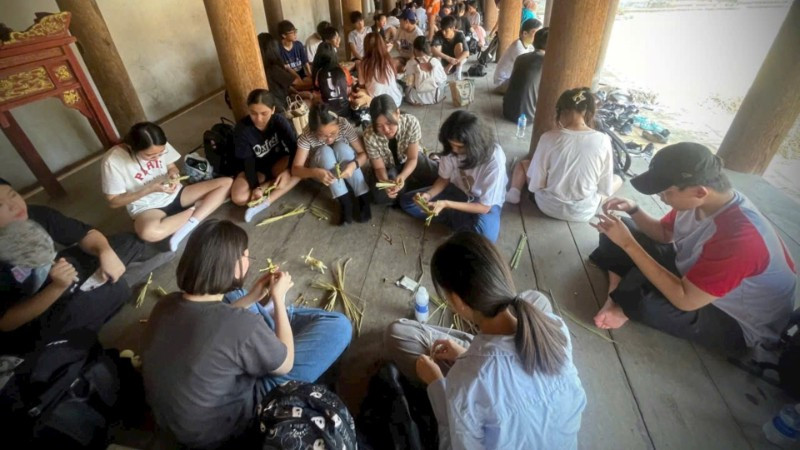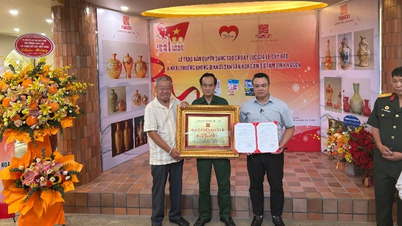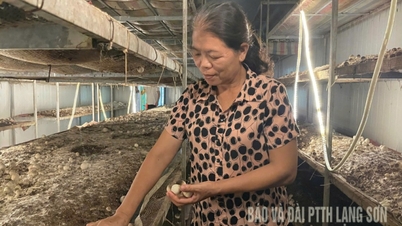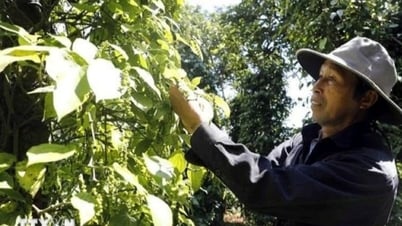
Recently, the Employment Law No. 74/2025/QH15 was passed by the National Assembly , effective from January 1, 2026, adding Chapter V on vocational skills development, recognizing both non-formal skills and orienting development according to the specific needs of employers.
Desire for revival
“I was born and raised in Son Tay, a place once famous for its Lo Noi pottery, but when I grew up, I saw that the pottery kilns had cooled down and the villagers had switched to other jobs,” shared artist and painter Nguyen Tan Phat (Son Tay ward, Hanoi ).
Because of his love for visual arts and his concern about the risk of losing his profession, Mr. Phat learned techniques from the last craftsmen, combined with research on old documents and images to restore the profession.
When he had the opportunity to work in Duong Lam Ancient Village, he chose to stick with it to both make Lo Noi pottery products and introduce them to tourists. In the workshop, in addition to the displayed products, there are always clay tables and tools for visitors to experience. Many visitors are surprised to hear the story of Lo Noi pottery of Phu Nhi village and feel the soul of the craft right from the first time they try it.
Artisan Tan Phat believes that tourism brings a stable source of income, creates jobs and helps spread the story of the profession. However, the lack of skilled successors remains a big challenge. “To attract young people, we need to show them that the profession brings a stable life, creative opportunities and pride in preserving identity, while combining traditional skills training with modern design, e-commerce and marketing,” said Mr. Phat.
Regarding the revised Law on Employment with its regulations on recognizing informal vocational skills, artisan Tan Phat expressed his support. In Duong Lam, most skilled workers come from traditional vocational training, without formal education, but their skills and expertise are not inferior. The State’s recognition of informal vocational skills will increase the value of workers, helping them gain more status in labor contracts, participate in projects, or access support policies, etc.
Meanwhile, in Bat Trang (Hanoi), most ceramic production activities still have the appearance of a long-standing traditional craft village. The kilns are located right in the family yard, the products are created by the coordination of many hands in a small team.
Ms. Pham Thi Thu Hoai, Deputy Head of the Inspection Committee of the Bat Trang Commune Party Committee, who used to be in charge of artisans in the craft village, said that most households still maintain the family economic model or individual business households. “Vocational training in Bat Trang is still mostly spontaneous, based on the specific needs of each household, and has not been organized in a professional direction with separate vocational training facilities.”
According to Ms. Hoai, the pottery making process has many stages, each stage requires a specific specialized worker. Usually, the kiln owner will observe and discover the talent of the worker in a certain stage, then provide intensive training in that stage to form a complete team to create a product.
Bat Trang always focuses on arousing the love of the profession for young people through traditional education, creating attraction when the products are both useful and rich in cultural values. For about 10 years now, many young people, especially university graduates, have returned to open kilns, apply digital technology, expand the market, and contribute to the development of the village. However, because it operates mainly according to the private economic model, retaining skilled workers is quite difficult. Many artisans only pass on their skills to relatives to ensure the preservation and promotion of the profession.
Regarding the Law on Employment (amended) with regulations on recognition of non-formal vocational skills, Ms. Hoai commented that this is a very important and practical policy for Bat Trang craft village in particular and craft villages in the country in general. This demonstrates the State's concern, while promoting more systematic and serious training of craft village workers, helping to improve the skills of artisans and skilled workers in a sustainable and specialized manner.
According to Ms. Hoai, in order for the training model associated with production and tourism in Bat Trang to be truly effective, specific policies are needed for localities with traditional craft villages. Only then can local authorities develop a project to train a workforce associated with traditional occupations (coordination between artisans and authorities), and at the same time develop a workforce associated with craft village tourism (connecting authorities and businesses).
Connecting policy and practice
Director of the National Center for Employment Services Ngo Xuan Lieu said that in recent times, the employment service center system has organized many job fairs both in person and online, while promoting career counseling and orientation with the participation of vocational training institutions. However, many craft villages still lack skilled workers, especially skilled workers, so close coordination between craft villages, associations and training institutions is needed. The National Target Programs on Sustainable Poverty Reduction and New Rural Development for the 2021-2025 period have been designed with specific activities to address this issue.
According to the General Statistics Office, by the second quarter of 2025, the proportion of trained workers with degrees and certificates will only reach 29.1%, while millions of workers in craft villages still have not had their skills recognized. Currently, the Department of Employment and related units are developing decrees and circulars to guide the implementation of the 2025 Employment Law, a document expected to create a boost for the labor market, improve the quality of human resources, improve recruitment of production and business establishments, and expand employment opportunities and income.
On that basis, the National Center for Employment Services will advise on the implementation of programs to improve labor quality, specify policies for specific target groups, including young people, and mobilize the participation of craft villages in the process of developing guiding documents, associated with tourism development and socio-economic-cultural development.
Source: https://nhandan.vn/dao-tao-lao-dong-o-lang-nghe-truyen-thong-post903140.html




































































































Comment (0)